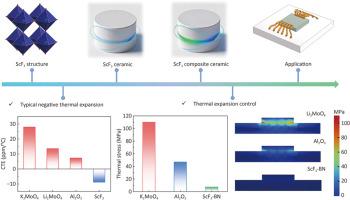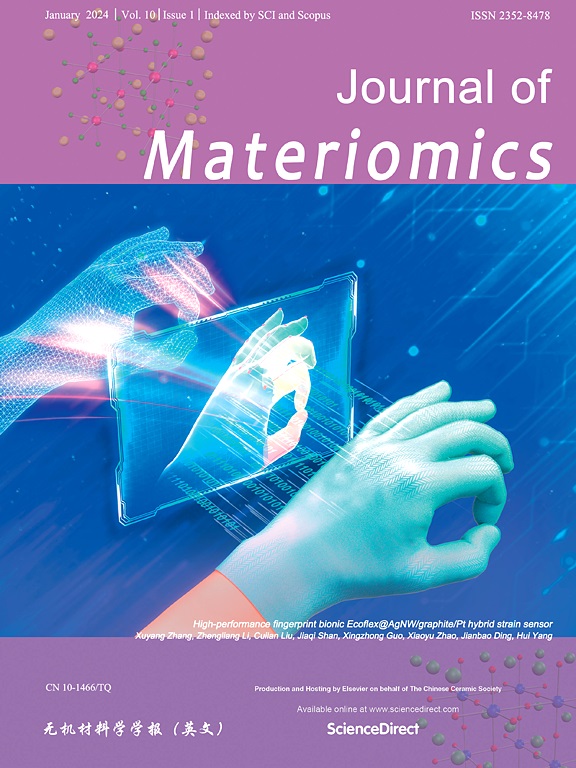负热膨胀ScF3陶瓷电子封装应用
IF 9.6
1区 材料科学
Q1 CHEMISTRY, PHYSICAL
引用次数: 0
摘要
为了满足现代电子封装小型化和集成化的要求,开发低热膨胀系数(CTE)材料是降低热应力和提高器件可靠性的必要条件。本研究以-8.86×10-6 /°C的CTE制备了致密负热膨胀陶瓷ScF3。ScF3陶瓷在150°C下进行冷烧结,其介电常数低至5.3,质量因子(Q×f)高达14,700 GHz。通过将ScF3掺入六方氮化硼(BN)陶瓷中,将ScF3-BN复合陶瓷的CTE调节到3.36×10-6 /°C,建立了与硅基芯片的相容性。有限元模拟验证了ScF3-BN复合材料与Li2MoO4或Al2O3陶瓷相比显著降低了热应力。此外,这项工作证明了冷烧结ScF3调节封装基板热膨胀的潜力,为提高下一代电子器件的性能铺平了道路。本文章由计算机程序翻译,如有差异,请以英文原文为准。

Negative thermal expansion ScF3 ceramic for electronic packaging applications
To meet the demands of miniaturization and integration in modern electronic packaging, developing materials with low coefficient of thermal expansion (CTE) is essential to reduce thermal stress and enhance device reliability. In this study, the dense negative thermal expansion ceramic ScF3 was prepared with a CTE of –8.86×10–6/°C. The ScF3 ceramic was cold sintered at 150 °C, exhibiting a low permittivity of 5.3 and a high quality factor (Q×f) of 14,700 GHz. By incorporating ScF3 to the hexagonal boron nitride (BN) ceramic, the CTE of ScF3-BN composite ceramic was adjusted to 3.36×10–6/°C, establishing compatibility with silicon-based chips. And finite element simulations verified that ScF3-BN composite significantly reduces thermal stress compared to Li2MoO4 or Al2O3 ceramics. Furthermore, this work demonstrates the potential of cold-sintered ScF3 to regulate thermal expansion in packaging substrates, paving the way for improved performance in next-generation electronic devices.
求助全文
通过发布文献求助,成功后即可免费获取论文全文。
去求助
来源期刊

Journal of Materiomics
Materials Science-Metals and Alloys
CiteScore
14.30
自引率
6.40%
发文量
331
审稿时长
37 days
期刊介绍:
The Journal of Materiomics is a peer-reviewed open-access journal that aims to serve as a forum for the continuous dissemination of research within the field of materials science. It particularly emphasizes systematic studies on the relationships between composition, processing, structure, property, and performance of advanced materials. The journal is supported by the Chinese Ceramic Society and is indexed in SCIE and Scopus. It is commonly referred to as J Materiomics.
 求助内容:
求助内容: 应助结果提醒方式:
应助结果提醒方式:


